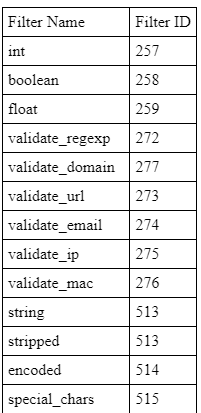PHP Filters
Validating data = Determine if the data is in proper form.
Sanitizing data = Remove any illegal character from the data.
The PHP Filter Extension
PHP filters are used to validate and sanitize external input.
The filter_list() function can be used to list what the PHP filter extension offers:
Example
<!DOCTYPE html>
<html>
<head>
<style>
table, th, td {
border: 1px solid black;
border-collapse: collapse;
}
th, td {
padding: 5px;
}
</style>
</head>
<body>
<table>
<tr>
<td>Filter Name
<td>Filter ID
</tr>
<?php
foreach (filter_list() as $id =>$filter) {
echo '' . $filter . ' ' . filter_id($filter) . '
Output

• Why Use Filters?
Many web applications receive external input. External input/data can be:
User input from a form
Cookies
Web services data
Server variables
Database query results
• PHP filter_var() Function
The filter_var() function both validate and sanitize data.
The filter_var() function filters a single variable with a specified filter. It takes two pieces of data:
The variable you want to check
The type of check to use
• Sanitize a String
The following example uses the filter_var() function to remove all HTML tags from a string:
<!DOCTYPE html> <html> <body> <?php $str = "<h1>Hello World!</h1>"; $newstr = filter_var($str, FILTER_SANITIZE_STRING); echo $newstr; ?> </body> </html>
Output
Hello World!
• Validate an Integer
The following example uses the filter_var() function to check if the variable $int is an integer. If $int is an integer, the output of the code below will be: "Integer is valid". If $int is not an integer, the output will be: "Integer is not valid":
<!DOCTYPE html>
<html>
<body>
<?php
$int = 100;
if (!filter_var($int, FILTER_VALIDATE_INT) === false) {
echo("Integer is valid");
} else {
echo("Integer is not valid");
}
?>
</body>
</html>
Output
Integer is valid
• Validate an IP Address
The following example uses the filter_var() function to check if the variable $ip is a valid IP address:
<!DOCTYPE html>
<html>
vbody>
<?php
$ip = "127.0.0.1";
if (!filter_var($ip, FILTER_VALIDATE_IP) === false) {
echo("$ip is a valid IP address");
} else {
echo("$ip is not a valid IP address");
}
?>
</body>
</html>
Output
127.0.0.1 is a valid IP address
• Sanitize and Validate an Email Address
The following example uses the filter_var() function to first remove all illegal characters from the $email variable, then check if it is a valid email address:
<!DOCTYPE html>
<!html>
<!body>
<!?php
$email = "john.doe@example.com";
// Remove all illegal characters from email
$email = filter_var($email, FILTER_SANITIZE_EMAIL);
// Validate e-mail
if (!filter_var($email, FILTER_VALIDATE_EMAIL) === false) {
echo("$email is a valid email address");
} else {
echo("$email is not a valid email address");
}
?>
<!/body>
<!/html>
Output
john.doe@example.com is a valid email address
• Sanitize and Validate a URL
The following example uses the filter_var() function to first remove all illegal characters from a URL, then check if $url is a valid URL:
<!DOCTYPE html>
<html>
<body>
<?php
$url = "https://www.codelines.com";
// Remove all illegal characters from a url
$url = filter_var($url, FILTER_SANITIZE_URL);
// Validate url
if (!filter_var($url, FILTER_VALIDATE_URL) === false) {
echo("$url is a valid URL");
} else {
echo("$url is not a valid URL");
}
?>
</body>
</html>
Output
https://www.codelines.com is a valid URL
